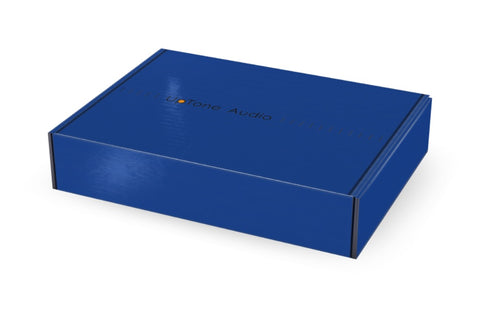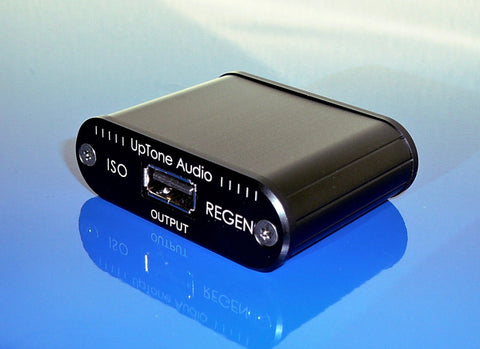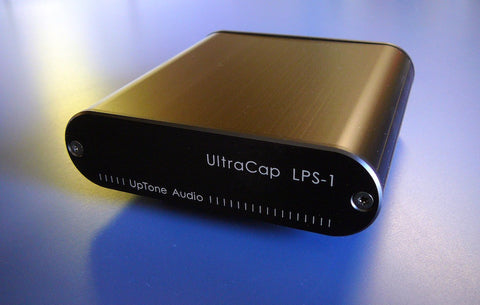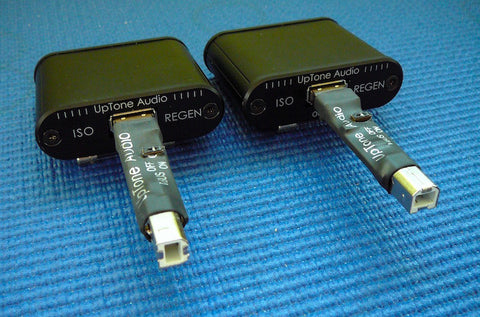UltraCap LPS-1.2
$ 435.00
In October 2016, UpTone Audio began shipping the revolutionary UltraCap LPS-1. By all metrics it can be considered a huge success. 1,650 units shipped (including in bundles with our very popular ISO REGEN), and orders continue to pour in for this small yet sophisticated 1.1-amp, bank-alternating, isolated and “floated” ultra-low-noise linear power supply.
Reviews—by users and web publication reviewers—have widely praised the LPS-1, and it won a 2017 Readers’ Choice Award at ComputerAudiophile.com.
So it is with great pleasure that we announce the retirement of the UltraCap LPS-1 and the birth of the UltraCap LPS-1.2!
User reviews of the new UltraCap LPS-1.2 are being posted in this thread at our sponsored forum at ComputerAudiophile.
Here is a recent sample:
"I recently replaced one of my LPS-1 with LPS-1.2, and like the result quite a bit. While trying this new supply, I also put it in other positions in my system to compare, the result in raising the SQ seems consistent, so a week later, I ordered another two to replace two other LPS-1's I have. With one week of burn-in, I am pleasantly surprised how much more the improvement is. I knew the improvement would be quite tangible, but for sure was not prepared to be this much. Overall detail retrieval, smoothness, dimensional layering, space between instruments are all took a nice step up. Kudos to UpTone for this fine product!" —Kevin S., Fremont, California
–––––––––––––––––––––––––––––––––––––––––––––––––
Below are highlights of the terrific enhancements incorporated into the redesign of our unique power supply:
(The announcement of the LPS-1.2 is taking place concurrently in our forum at ComputerAudiophile, so the these verbose details are a duplicate of what is being posted there. This product page will be consolidated—and photos updated—after the launch.)
- Where previously the user adjustable output voltages of the LPS-1 were 3.3V, 5V, and 7V, the new UltraCap LPS-1.2 offers you 5V, 7V, 9V, and 12 volt output choices. This broadens the range of devices that can be powered. Maximum guaranteed output current—at all voltages—is still 1.1A.
- The output voltage regulators—previously a cascade of the very fine (4.2µV/RMS noise) Texas Instruments TPS7A4700—have been changed to the truly extraordinary (0.8µV/RMS!) Linear Technology LT3045—a pair of them paralleled in a configuration that further lowers output impedance. We are down into the 3mOhm (10Hz-100KHz) range now!
- A power on/off switch has been added. Some people prefer to turn off the supply at times. Now you can do so without having to unplug any cables.
- The complex charging circuity has been redesigned around the very expensive ($28 each whether we buy 100 or 1,000 pcs.) Linear Technology LTM4607 regulator micro-module. This was done both to allow for the higher (18V) internal charge voltages required to offer the 12V output, and to improve reliability and robustness of the input side of the unit. (A few people have fried their LPS-1 units with over-voltage spikes from 3rd-party chargers.) As you can see from the back panel, the input voltage range has been expanded; the LPS-1.2 can run off chargers from 7-24V.
- The electrical math of providing the new 9-volt and 12-volt output settings on the LPS-1.2 necessitates the use of a higher wattage AC>DC power supply to “energize”/charge the unit. The strict requirement for the charger is now 36 watts—and we print this on the back panel. As before, we are flexible with regards to the voltage of the charger—but the charger voltage times its current capability MUST equal 36W or greater. (So you can see 7.5V/4.8A, 9V/4A, 12V/3A, 18V/2A, 24V/1.5A are all acceptable charger ratings.)
- The UltraCap LPS-1.2 has a small, 3-pin (standard 0.1” header pin spacing) port for measuring output voltage and device current draw. Typically measuring the current draw of a device requires putting an ammeter in series with the power cable (DC or AC) feeding it. But this clever port provides a measurement of current with a voltage: 1 Volt equals 1 Amp. So if you measure 0.2V (across the pins labeled ‘G’—for ground—and ‘I’—for current), that means the device you have attached to the output is drawing 0.2A or 200mA. The pin labeled ‘V’ always outputs the voltage that the LPS-1.2 is set to. Small displays are available cheaply to use this, and we may develop our own little display board to peek up from back of the unit.
––––––––––––––––––––––––––––––––––––––––––––––––––––––
The world's first bank-switching, microprocessor-controller, ultracapacitor-based, ultra-low-noise external linear power supply has arrived!
In development for more than a year, and with 262 parts on the double-sided, 4-layer circuit board, this tour de force of engineering challenges traditional notions about what is important in power supply design.
Use of the UltraCap™ LPS-1.2 in a quality music reproduction system will yield surprisingly audible improvements, and we invite comparisons to any other low voltage linear power supply.
The LPS-1.2 is a single output, 1.1-amp linear power supply intended for powering a wide range of audio and computer devices. Examples include: UpTone's own ISO REGEN, the Sonore microRendu and ultraRendu, SOtM streamers, small DACs and headphone amps, USB>S/PDIF converters, specialty computer USB cards, SSDs, fibre media converters, PS Audio LANRover, SqueezeBox Touch, etc.
A switch on the back of the LPS-1.2 allows for setting of the output voltage to 5V, 7V, 9V, or 12 volts. The input and output jacks of the LPS-1 are standard 5.5mm x 2.1mm size DC barrel connectors.
The dimensions of the LPS-1.2 are: 110mm (4.33 inches) wide x 112mm (4.41 inches) deep x 30mm (1.18 inches) tall; Add 6.5mm (0.26 inches) for included rubber feet.
Included with the LPS-1.2:
A 70cm, 16awg, DC cable with 5.5mm x 2.1mm plugs at both ends (correct for our REGENs, the Sonore Rendus, and many other popular devices which use that size).
A custom 7.5V/4.8A/36W world-voltage-compatible tabletop SMPS for "energizing" the UltraCap™ LPS-1.2, along with a 45cm AC power cable (standard IEC plug one end, USA wall plug at the other—international buyers can cut and put a local plug on or just use any standard power cord).
An LED at the back of the LPS-1.2 changes color (red/amber/green) based on the status of the supply. The programming of its 4096 logic-element FPGA controls and protects every aspect of its operation to assure safe and reliable performance.
There has never been a power supply like this before! The UltraCap LPS-1.2 will elevate the performance of whatever component you power with it.
[The adventurous could even purchase two units and hook their outputs up in series, with each one set to either the same or a different voltage—making possible 10/14/16/17/18/19/24V! ; An even more interesting application would be for a DIY hobbyist to use two units harnessed together and center-tapped to produce a pure and isolated bi-polar (+ & -) supply for audio circuit use.]
*************************
User reviews of the original version LPS-1 are abundant Please visit: the "UltraCap LPS-1 Listening Impressions" thread at ComputerAudiophile.com, and Stereophile/AudioStream reviewed the LPS-1 as well.
*************************
SO WHAT ARE ULTRACAPACITORS AND WHY ARE THEY EXCITING FOR USE IN AUDIO POWER SUPPLIES?
Think of ultracapacitors (technically "electric double-layer capacitors" and often called supercapacitors) as a cross between a battery and a regular storage capacitor. They offer:
*High energy storage density--Small ones are 1 Farad (as opposed the microFarad scale typically used for power supply caps), and the bigger ones range from 150 Farads to 500 Farads! The LPS-1 has a total of 60 Farads of supercaps.
*Very low ESR (equivalent series resistance)--Much lower than batteries, and they can discharge VERY fast, thus delivering a lot of energy quickly. These are important attributes for an audio component power supply.
*Very fast charge times--and designed with properly, they can be charged/discharged millions of times.
[If you wish to learn more about EDLCs/ultra/super caps, here are a couple of good places to start:
https://www.tecategroup.com/ultracap...acitor-FAQ.php
https://en.wikipedia.org/wiki/Supercapacitor ]
*************************
It is true that low noise is important to power supply performance, and we parallel a pair of the world's lowest noise (0.8µV/RMS) integrated regulators--the extraordinary Linear Technology LT3045--for the 1.1-amp output of the UltraCap LPS-1.2. Yet just producing a low noise output is not what sets the LPS-1.2 apart from other linear power supplies.
Components that an external DC supply will be used to power already have their own low-noise voltage regulators inside them (most of which are nowhere near as quiet as those in the LPS-1.2), so the audible advantage from using this UltraCap™ power supply—versus a stock PS or a competitor's LPS—is not entirely about low noise.
Rather, the two main advances of UpTone Audio's groundbreaking new power supply are:
1) Speed and ultra-low output impedance over a broad bandwidth. (Battery supplies are poor in this regard; And many traditional traditional transformer/diode/capacitor/regulator linear PS units rely on big banks of filter caps to smooth what the regulator sees—which impacts speed and impedance.)
2) 100% galvanic isolation from the AC mains at all times. While one bank of ultracapacitors is supplying output, the other bank is charging. The output is never connected to the bank that is recharging, and the sophisticated design ensures silent and smooth transitioning from one bank to the other.
The most important result of the isolation afforded by the UltraCap™ LPS-1.2 is that it completely blocks the path of AC LEAKAGE CURRENTS. Some more in-depth information on the subject can be found on the Swenson Explains page, and here is bit more condensed explanation of this important topic—also written as a forum post by John Swenson:
The PRIMARY purpose of the LPS-1.2 is to break leakage current induced ground loops, (which exist in almost all systems), and the fact that the output is isolated from the input (thus not affected by noise of the feeder supply) is a bonus, not a primary goal. Of course the LPS-1 has a very low noise, very low impedance output as well.
There are two very different mechanisms by which an AC power supply can interact through the AC mains:
1) traditional "noise injected back into the AC line." This is easy to measure, easy to grasp what is happening, and many devices exist to try and filter out this sort of noise.
2) Leakage current, this is created by capacitances between the AC line and the DC output of the supply, it ALWAYS exists but varies from supply to supply. This is hard to measure, hard to grasp what it is and how it propagates through a system. After everything else is taken care of the leakage current is still there, I consider it to be one of the last great untouched detriments to obtaining best sound.
Both #1 and #2 exist in almost any system to varying degrees. Since there is already a large body of knowledge and products to deal with #1, I set out to work on finding ways to deal with #2. The LPS-1 is the first fruit of that work.
Leakage current has always been there, but has not been a big issue until recently for two reasons:
A) it is fairly low level in most systems so its effects have been masked by all the other problems preventing our systems from being their best, as these other sources of problems have been identified and addressed, the sonic results of the leakage current are now much more obvious.
B) leakage current from SMPS is usually much higher than from LPS, so the inclusion of computers (which are usually run from SMPS) into systems has greatly exacerbated the sonic detriment due to leakage current.
*************************
Please visit our sponsored forum at ComputerAudiophile.com to learn more about this and other exciting UpTone Audio components.




